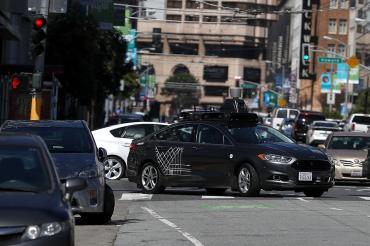U of T expert on why we should embrace self-driving cars

Published: April 3, 2018
The self-driving car crash in Tempe, Ariz., in which a car struck and killed a woman crossing the street, has started a vigorous debate that has some questioning the merits of self-operating machinery.
It's a debate that interests Luc Tremblay, an associate professor at the University of Toronto’s Faculty of Kinesiology and Physical Education whose research interests include multisensory integration, neuromotor control of voluntary action and use of sensory information.
“Hopefully, we will recognize the broader and improvable capacities of self-driving cars, the limited and easily weakened driving capacities of humans, our biased emotional responses to risks and change, and the need to make cities more accessible,” he says in an interview.
“We need to acknowledge our emotional response to systems that are not under our direct control and that such systems could ultimately decrease the overall odds of ever getting injured or dying in a car accident.”
How justified are people’s concerns about self-operating machinery?
The reaction times of human beings are slower than that of machines, but most people feel safer when they are in control. When travelling overseas, we might assess the airplane takeoff and landing as the most dangerous parts of our trip. However, driving to and from the airport is much more likely to be the cause of injury or death. Autopilots on commercial airplanes have consistently reduced the risks over the last decades, and the systems continue to improve. Yet, we cannot help but feel concerned and worried because we are not in control.
But why allow our intuition and natural resistance to inform how we react to technological developments? This is especially problematic considering the need to have a more inclusive and accessible society.
How can self-driving cars contribute to a more inclusive and accessible society?
Cities of the future will be accessible to more individuals in various states of their lives. Increasing accessibility can be uniquely facilitated by self-driving cars. Whether it is because we are tired, experiencing a temporary incapacity (for example, a broken arm or leg), or a permanent physical challenge (blindness), self-driving cars could allow every citizen to obtain safe and direct origin-to-destination transportation.
Also, self-driving cars could provide such access in ways that cannot be provided by mass transit systems, potentially benefiting everyone from chemotherapy patients to parents with small children.
So, are you saying give self-driving cars a chance, despite the shaky debut?
Not all self-driving cars should be deemed as having a rough start. One company recorded four million miles without any major incidents. Hopefully, we will recognize the broader and improvable capacities of self-driving cars, the limited and easily weakened driving capacities of humans, our biased emotional responses to risks and change, and the need to make cities more accessible.
We need to acknowledge our emotional response to systems that are not under our direct control and that such systems could ultimately decrease the overall odds of ever getting injured or dying in a car accident.
More importantly, tolerating, accepting and embracing self-driving cars will provide a broader access to life and society to all citizens, throughout their entire lives.
In the Arizona incident, how did Uber’s self-driving system, with its lidar laser sensor that sees in the dark, fail to avoid hitting the woman?
The video of the accident released by the police shows the self-driving car’s video system failed to promptly identify the human walking behind the bicycle and thus brake in time. That raises questions about the equipment used to detect people on the road. However, we also need to recognize that machines have the potential to have better sensing levels than humans.
Would a human driver have responded differently?
People watching the video of the incident may think that they could have saved the pedestrian’s life. However, they clicked on an internet link telling them that they will be seeing an accident about to happen. When asking someone to detect a simple signal and then react, the reaction can take as little as 0.2 seconds. But the signal is known and the odds of reacting are 100 per cent.
If you do not know what the signal is going to be or if it will happen at all, the reaction times decrease dramatically. And that is presuming that the driver’s eyes are on the road, which was not the case of the self-driving car tester in this incident. What this tells us is that self-driving car tests need to be revised to ensure that the person sitting in the test self-driving car is always paying attention to the road.
At the same time, we need to recognize that self-driving cars can have their “eyes” on the road at all times, with machine reaction times – once the risk is recognized – closer to 0.01 seconds.



